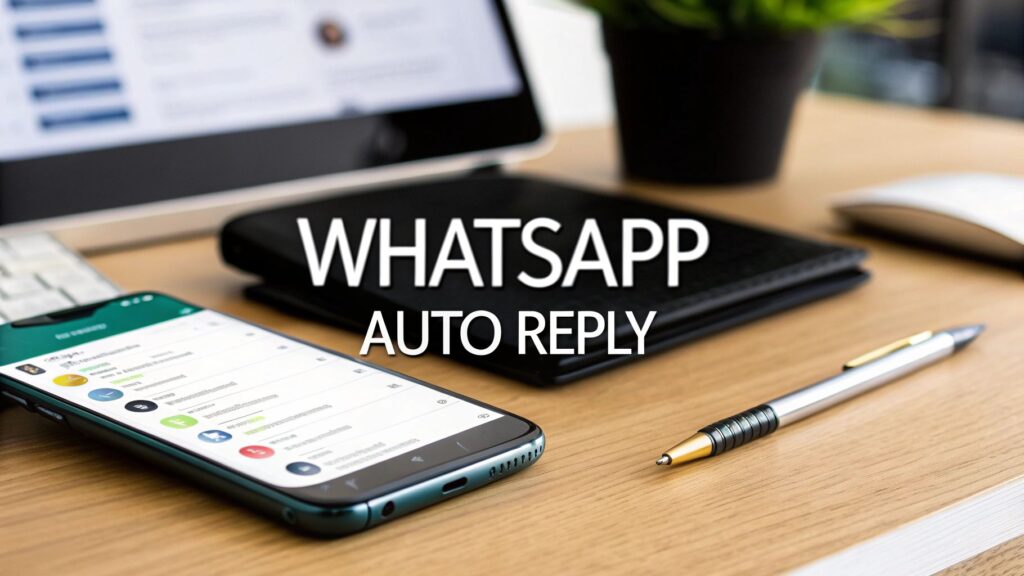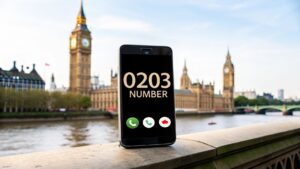A WhatsApp auto reply is your business's digital front door. It’s a pre-written message that the free WhatsApp Business app sends automatically when a customer gets in touch. Think of it as your secret weapon for instantly acknowledging new enquiries, setting expectations when you're off the clock, and making every customer feel valued.
Why a WhatsApp Auto Reply Can Make or Break Your Business
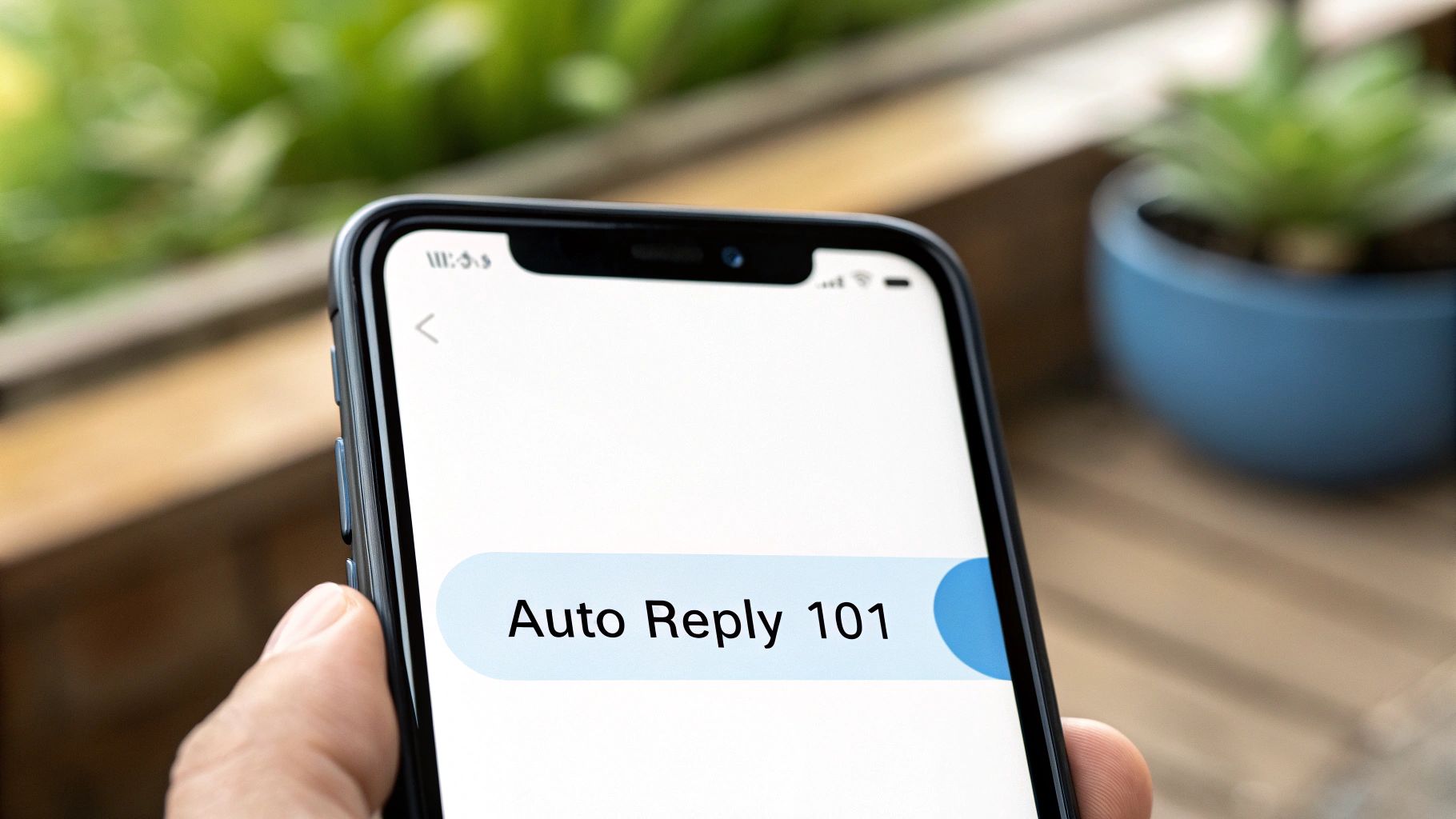
Let's be honest, in today's market, speed is everything. When a potential customer messages you, they expect a reply almost instantly, not hours later. If that first message is met with silence, they’ll simply move on to a competitor who answers faster. This is where a smart WhatsApp auto reply stops being a "nice-to-have" and becomes a critical part of your sales process.
For small businesses, freelancers, and online shops, this isn't just a gimmick. It’s about projecting a professional image and giving the impression of 24/7 availability—even if you’re a team of one juggling a dozen other tasks.
Securing Leads After You've Clocked Off
Picture this: it's 9 PM on a Tuesday, and a promising new client messages your business for a quote. Without an automated reply, that message just sits there, unread. By the time you see it the next morning, there’s a good chance they've already found and hired someone else.
Now, imagine that same scenario with an auto-reply. A simple, friendly message like, "Thanks for getting in touch! We're currently closed for the day but will reply first thing tomorrow morning," completely changes the dynamic. It instantly acknowledges them, manages their expectations, and keeps your business in the game. You've just turned a missed opportunity into a warm lead waiting for you in the morning.
Building Trust, One Instant Reply at a Time
You really can't underestimate the power of an instant response, especially here in the UK. WhatsApp isn't just popular; it's a primary communication channel. A massive 73% of UK internet users between 16 and 64 use the app every month.
More importantly, 56% of UK shoppers admit they'll ditch a purchase if a business takes too long to respond. Those numbers tell a clear story: immediate replies are non-negotiable. If you're curious about the data, you can explore more WhatsApp statistics and their impact on UK sales.
An auto-reply isn't just a placeholder message. It’s your first handshake, the first step in building a solid customer relationship. It shows you’re organised and that you respect their time.
Setting up auto-replies provides a simple solution to some very common business headaches.
Here’s a quick breakdown of how this small feature can have a big impact:
Instant Impact of WhatsApp Auto Reply
| Business Challenge | Auto Reply Solution | Customer Benefit |
|---|---|---|
| Missing leads outside of business hours | Sends an immediate "Away Message" | Feeling acknowledged and knowing when to expect a reply |
| Appearing unprofessional or slow | Projects an organised, responsive image | Increased trust and confidence in the business |
| Customer frustration from being ignored | Provides instant confirmation of receipt | A positive first impression and a better overall experience |
| Juggling too many enquiries at once | Buys you time to respond thoughtfully | Reduced anxiety, as they know their message was delivered |
Ultimately, a WhatsApp auto-reply is a foundational tool for modern customer service. It doesn't just plug a gap in your communications; it helps you capture every opportunity, build trust from the word "go," and lay the groundwork for real business growth.
Your First Steps with WhatsApp Auto Reply Setup
Getting started with a WhatsApp auto reply is much simpler than most people think. You won't need to be a tech wizard to get your first messages up and running; the tools are already built right into the free WhatsApp Business app. Think of this as your first step towards creating a professional, responsive front for your business, even when you can't be there to reply in person.
The app gives you two core tools to start with: the Greeting Message and the Away Message. Each serves a unique purpose, but both are vital for managing customer conversations and setting clear expectations right from the start.
Greeting Messages for New Enquiries
Your Greeting Message is your digital receptionist. It’s an automated response that gets sent to customers when they message you for the first time, or if they haven't been in touch for 14 days. This is your golden opportunity to make a brilliant first impression.
For example, a freelance consultant could use their greeting message to qualify new leads right away: "Thanks for getting in touch! To help me understand what you're looking for, could you give me a brief overview of your project? I'll take a look and get back to you within 24 hours."
This simple message accomplishes three things almost instantly:
- It acknowledges the customer, so they know their message has landed safely.
- It gathers key information upfront, saving you from back-and-forth emails later.
- It manages expectations by giving a clear timeframe for a personal follow-up.
Away Messages for After-Hours Cover
The Away Message is your out-of-office hero, perfect for handling enquiries that come in after you've packed up for the day. This is absolutely crucial for avoiding that dead air that can make a potential customer look elsewhere.
Imagine a local bakery that closes at 5 PM. Their away message might read: "Thanks for messaging The Flour Pot! We're currently closed for the day but will be back at it from 8 AM to 5 PM, Tuesday to Saturday. We'll reply to your message first thing tomorrow morning!"
It's a small touch, but a powerful one. You can schedule it to switch on automatically outside your business hours, so you never have to remember to flick a switch.
A great away message does more than just say "we're closed." It reinforces your professionalism, shares useful info, and reassures customers that you value them, even when you're off the clock.
The setup process inside the WhatsApp Business app is designed to be completely straightforward. This visual gives you a quick look at the basic steps for enabling your first auto reply.
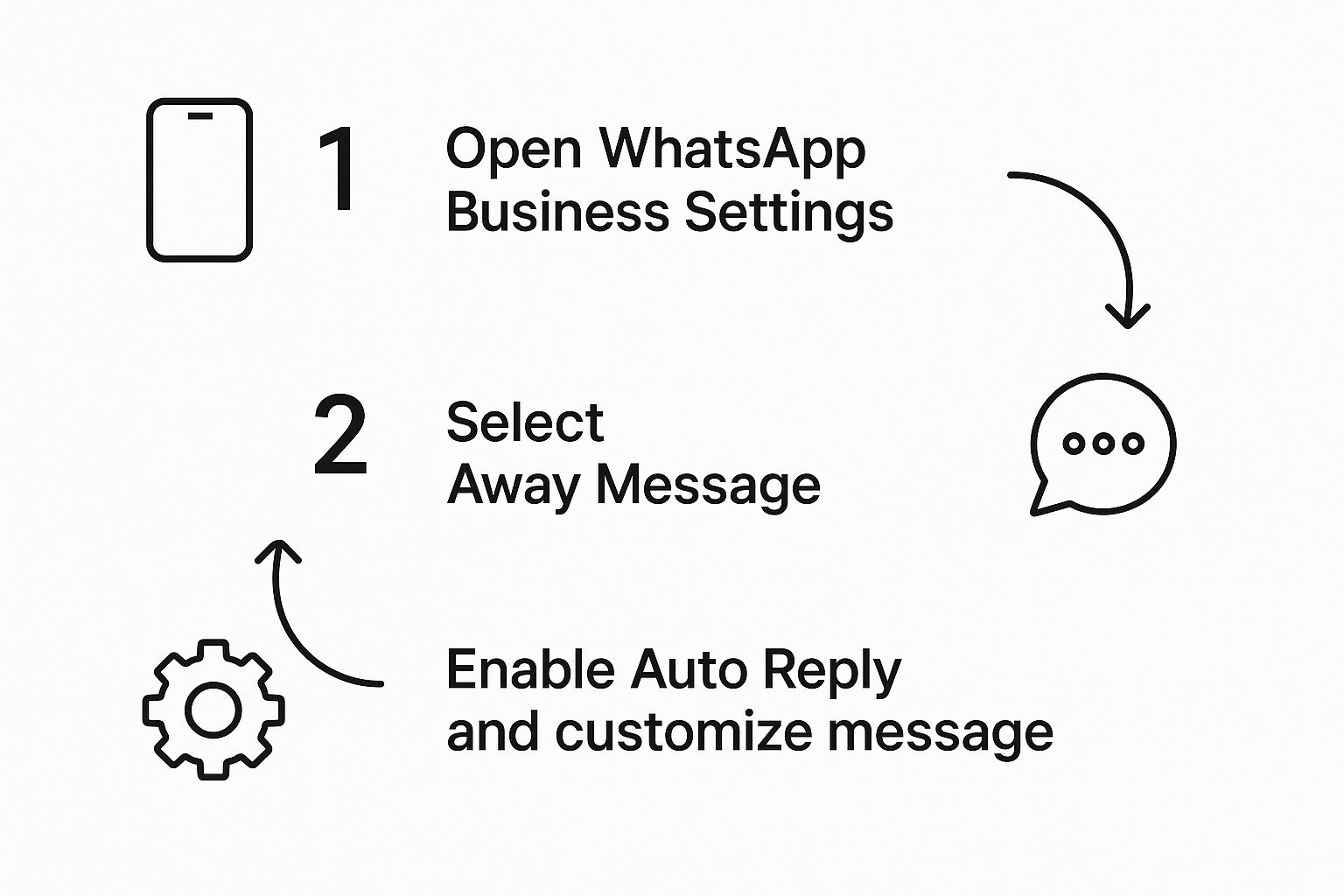
As you can see, activating your first WhatsApp auto reply is just a matter of a few taps in the business tools settings.
Customising Your Auto Reply Audience
When you're putting these messages together, WhatsApp lets you decide exactly who sees them. You can send them to everyone who messages you, or you can get a bit more targeted.
You’ve got a few options for recipients:
- Everyone: The catch-all option for every single incoming message.
- Everyone not in address book: Perfect for greeting new contacts who aren't saved on your phone.
- Everyone except…: Handy for excluding people you don't need to send an auto reply to, like your staff or suppliers.
- Only send to…: Great for targeting specific customer groups with a tailored message.
Getting a handle on these basic settings is a quick win. You can immediately elevate your customer service, capture more leads, and project a more professional brand image—all within a few minutes.
Crafting Auto-Reply Messages That Connect
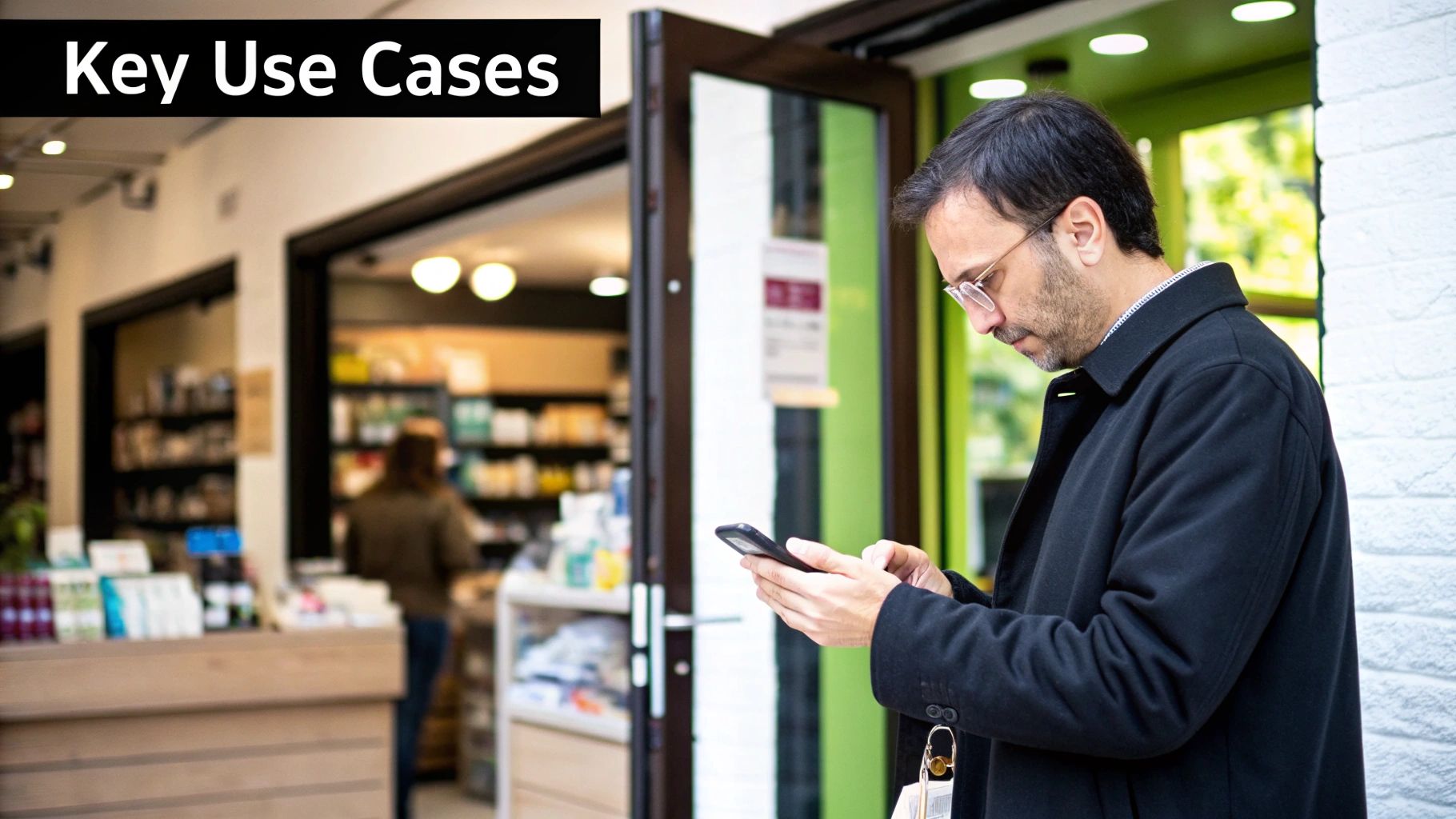
An auto-reply can be a powerful first impression or a robotic dead end. The difference almost always comes down to the words you choose. A truly effective WhatsApp auto-reply does more than just say "we got your message"; it starts building a relationship, manages expectations, and gives a glimpse of your brand's unique personality.
Think about it from the customer’s perspective. This automated response is often their very first direct interaction with your business. It's your one shot to sound helpful and human, not like a machine is running the show. The goal is to write replies that genuinely help people and leave them feeling good about reaching out.
This means moving away from the bland, corporate-speak that plagues so many automated messages. Let's focus on crafting messages for real-world scenarios, making sure they sound like they came from a person who genuinely cares.
Sounding Human and Setting Clear Expectations
The number one mistake businesses make is sounding robotic. The trick is to inject your brand’s personality while staying professional. A friendly, conversational tone works wonders.
Just as important is managing expectations. Be honest about your response times. It's far better to promise a reply within 24 hours and get back to them in six, than to promise an immediate response and fail to deliver. Honesty builds trust.
Your auto-reply isn't just an automated task; it's a promise to your customer. Be crystal clear about when they can expect a real person to get back to them. This simple act of transparency prevents frustration and shows you respect their time.
Here are a couple of examples that work really well for different business needs.
1. The Warm Welcome & Lead Capture
This approach is perfect for a service-based business, like a local tradesperson or a consultant, when a new lead gets in touch.
- Example: "Hi there! Thanks so much for reaching out. To help us get you the right information quickly, could you tell us a bit more about the project you have in mind? We'll take a look and get back to you with a proper response within the next few business hours. Cheers!"
2. The Helpful "Out of Office" Notice
Ideal for a small retail shop or an e-commerce store after you’ve clocked off for the day.
- Example: "Thanks for your message! You've caught us after we've packed up for the day. Our team is available from 9 AM to 5 PM, Monday to Friday. We'll be sure to reply first thing when we're back. In the meantime, you might find our FAQ page helpful: [Link to your website's FAQ page]"
Common Mistakes to Avoid in Your Messages
Knowing what not to do is half the battle. So many businesses fall into the same traps, turning a potentially helpful WhatsApp auto-reply into something that actually frustrates customers. Steering clear of these pitfalls is just as crucial as writing great copy.
Here are a few common blunders to avoid:
- Using Stiff Corporate Jargon: Ditch language like "Your inquiry has been received and will be processed accordingly." It’s cold and impersonal. Just speak like a human!
- Forgetting to Update: An auto-reply mentioning a bank holiday closure or a specific sale is great—until the event is over. An outdated message looks sloppy and unprofessional. Set a reminder to change it back.
- Writing an Essay: No one wants to read a wall of text. Keep your messages short, sharp, and scannable. A quick confirmation and the key info is all they need.
By focusing on a human tone, setting realistic expectations, and sidestepping these common errors, your automated messages become a genuine asset. They won’t just manage your inbox more efficiently; they’ll start building stronger customer relationships from the very first hello.
Going Pro: Advanced Automation with the WhatsApp API
The standard WhatsApp Business app is a brilliant tool for getting started. But what happens when your business starts to really grow? When you're juggling a constant stream of messages and the basic greeting and away messages just aren't cutting it anymore, it’s time to look at the WhatsApp Business API.
Think of it this way: the standard app is like having a friendly shopkeeper at the door. They can greet people and tell them when you'll be back. The API, on the other hand, is like having a fully-trained, multilingual concierge team that works 24/7. It's built for scale, intelligence, and serious efficiency.
What Exactly Is the WhatsApp Business API?
Unlike the app on your phone, the API isn't something you can just download. It’s a bridge that connects your WhatsApp account to more powerful business software, like your company's Customer Relationship Management (CRM) system or a specialised chatbot builder.
This connection is where the magic happens. It allows you to build completely automated, interactive conversations that can handle complex jobs without a human ever needing to step in. You're building a system that can genuinely understand what a customer wants and respond instantly.
For example, with the API, you could automatically:
- Ask new leads a few qualifying questions to gauge their interest.
- Instantly pull up a customer's order history from your Shopify store.
- Route a complex support issue straight to the right person on your team.
Building Smarter Communication Flows
The real beauty of the API lies in creating conversations that feel personal and dynamic. When you link WhatsApp to your CRM, an auto-reply can do more than just say hello. It can greet a returning customer by name and ask if they need help with their recent purchase. That kind of personal touch makes your business feel incredibly switched-on.
You can also get clever with keyword triggers. Imagine a customer messages you with the word "pricing". Instead of a generic "we'll get back to you," the API can fire off a specific message with your price list and a follow-up question, like "Would you like to chat with our sales team?"
The API turns your WhatsApp from a simple messaging app into a core part of your sales and support engine. It lets you create smart mini-chatbots that qualify leads, answer FAQs, and free up your team to handle the conversations that truly matter.
This isn't just a niche trick; it's fast becoming standard practice. It's projected that 80% of large UK enterprises will be using the WhatsApp Business API by 2025. Why? Because it drives real results, with some businesses seeing savings of up to 30% on their communication costs. If you want to dive deeper into the numbers, you can discover more insights about WhatsApp Business trends on d7networks.com.
How to Get Started with the API
So, how do you get access? You’ll typically work with a WhatsApp Business Solution Provider (BSP). These are official partners that provide the platforms and tools you need to build and manage these advanced automations.
While "API" sounds technical, don't be put off. Many providers have created incredibly user-friendly platforms with visual, drag-and-drop builders. You can map out entire chatbot conversations without writing a single line of code. This makes powerful automation accessible for any business ready to upgrade its WhatsApp auto reply game.
How to Measure and Refine Your Auto-Replies
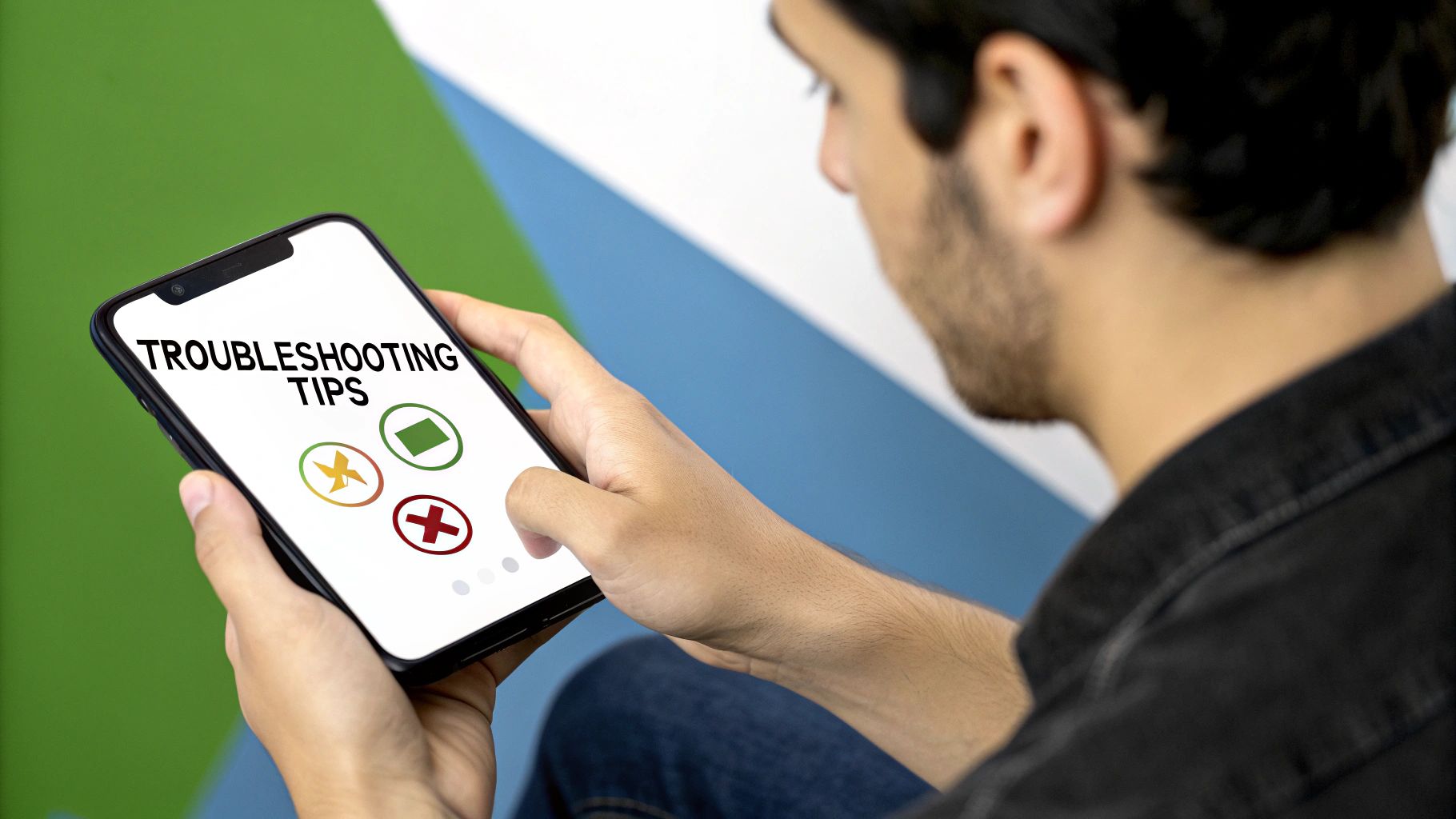
Getting your first WhatsApp auto-reply up and running is a solid first step. But if you really want to see results, you can't just set it and forget it. Many businesses miss out because they treat auto-replies as a one-and-done task. The real magic happens when you start testing, measuring, and refining what you send.
Think of your automated messages as dynamic, evolving conversations. The aim is to turn a simple feature into a powerhouse that actually improves your business, whether that's by getting you better leads or just making customers happier.
The best part? You don't need a data science degree to get started. Both the free WhatsApp Business app and the more advanced API give you the tools to figure out what’s working.
Key Metrics to Start Tracking
To know if your auto-replies are doing their job, you need to look at what happens after the message is sent. It's about more than just deliverability.
Focus on these three things first:
- Lead Quality: Take a look at the enquiries that come in after the auto-reply. Are they from serious prospects, or just tyre-kickers? If your message sets the right expectations, the quality of your leads should go up.
- Customer Sentiment: How do people respond? Do they sound happy and ready to move forward, or confused and frustrated? A positive tone in their reply is a huge win. Silence or annoyance tells you something needs to change.
- Response Rate: Do people actually reply to your automated message, or is it a conversation killer? If lots of chats die right after your auto-reply, it’s probably a sign that it feels too robotic or isn't helpful.
How to Gather Actionable Data
Getting this feedback is simpler than it sounds. If you're on the standard WhatsApp Business app, your analysis will be more hands-on. It's about paying close attention to the flow of conversations and spotting patterns yourself.
For businesses that are scaling, the data gets much more interesting. Meta is pushing hard to monetise the platform, with revenue projections around $15.6 billion annually, mostly from Business API fees. This means better analytics are constantly rolling out. With 33% of UK users saying immediate help is important, getting these messages right is a massive advantage. In fact, 12% of business accounts are already using premium tools to track performance. You can read more about WhatsApp's impact on business.
Don't just focus on what customers say; watch what they do. If your auto-reply includes a link, are they clicking it? If you ask a question to qualify them, how good are their answers? Action is the clearest form of feedback.
A simple but powerful technique is A/B testing. It’s not as complicated as it sounds. Just create two versions of your away message. Maybe one is super casual and friendly, while the other is more direct and professional.
Run version A for a week, then switch to version B for the next week. At the end, compare the results. Which one led to more sales? Which one got better replies? This straightforward cycle of testing and refining is what separates a basic WhatsApp auto-reply from one that genuinely drives your business forward.
Even with the best strategy, a few practical questions always pop up when you start using a new tool. Let's tackle some of the most common queries we hear from business owners about WhatsApp's auto-reply feature.
Getting these details sorted now will save you headaches later and give you the confidence to make the most of your automated messages.
Can I Set Up an Auto-Reply on My Personal WhatsApp?
Unfortunately, no. The auto-reply function is a business-specific tool, meaning you'll only find it on the WhatsApp Business app and the more advanced WhatsApp Business API. Your standard personal account, the one you use for friends and family, doesn't have these features built-in.
To get started, you'll need to download the free WhatsApp Business app from your app store and set up a proper business profile.
Will My Customers Realise It's an Automated Message?
This really comes down to your wording, but it's always better to be upfront about it. Honesty builds trust. A great auto-reply acknowledges that it's automated and sets a clear expectation for when a real person will get back to them.
For example: "Hi there! This is an automated reply just to let you know we've got your message. One of our team will be with you personally within the next 2 hours."
This simple, transparent approach keeps customers in the loop, prevents any frustration, and maintains a professional, helpful tone.
Does It Cost Anything to Use WhatsApp Auto-Replies?
For most small businesses, there are no costs involved. The standard WhatsApp Business app includes 'Away Messages' and 'Greeting Messages' completely free of charge. It's a fantastic starting point for freelancers and small teams.
The costs only begin if you decide to scale up and use the WhatsApp Business API for more complex automation. Meta charges for conversations through the API, though you do get your first 1,000 conversations each month for free. On top of that, you'll have a subscription fee for the third-party software you use to connect to the API.
How Can I Switch Off the Auto-Reply When I'm Back Online?
Toggling your auto-replies on and off is straightforward right inside the WhatsApp Business app.
Simply head to Settings > Business Tools > Away Message (or Greeting Message). You can flick the switch to turn it off completely.
Even better, you can set a schedule. By configuring your 'Away Message' to only send outside of your business hours, it effectively turns itself off the moment your workday begins. This "set it and forget it" method is by far the most efficient way to manage your WhatsApp auto reply.
Ready to separate your personal and business communications and create a professional presence on WhatsApp? With Business Numbers Direct, you can get a dedicated virtual number for your WhatsApp Business profile in under five minutes, all for just £7.99 a month, with no contract. It's the simplest way to unlock powerful features like auto-replies, product catalogues, and more, all from your existing smartphone. Start building a better business presence today at Business Numbers Direct.

